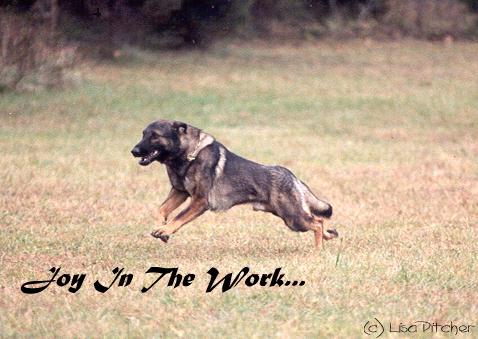
For a more than just a few years, I was an ardent supporter of the United Schutzhund Clubs of America (USA)--I edited the national magazine and wrote articles and I was a breed warden and tattooer. I have titled 4 dogs in Schutzhund and put breed surveys on 3 of them. I competed nationally with Thorn and Ash, and with Ash, I won the first ever H.O.T (Handler-Owner Trained) competition at the Sch1 level and we went back the next year and won the Sch3 level. I threw my life into it for nearly 10 years.
USA is an organization that began as a way to have schutzhund clubs and competitions and recognized titles in the U.S. But USA gradually migrated to aligning itself more and more closely with the SV--the Deutsche Schaferhund Verein--basically, the German breed club for German Shepherd Dogs. From the SV, grew the WUSV--the World Union of SVs, basically.
The GSD in Germany is closely regulated--you are required to have every litter of puppies inspected by breed wardens (who check for failing puppies, genetic and inherited flaws from rear dewclaws to cleft palates to non-accepted colors), then you are required to have an official tattooer come and tatoo your litter at 8 weeks. (All tattooers are breed wardens; not all breed wardens are tattooers.) In order to have a litter tattooed, in Germany, you had to have both parents with a working title, such as a herding (HGH) title or a Sch1 title.
In addition, in order to get the coveted "pink papers"--the highest grade of registration, both parents had to have been surveyed and passed the "Koerung"--an examination of size, weight, temperament, conformation, and working ability. Prerequisites for the Koerung are either an approved hip certification, an HGH or a Sch1 (or police certification, I believe), an AD (a 12-mile bike endurance test at a set speed), and have a conformation rating of G (good) or better (SG = Very Good; V = Excellent; VA = Excellent Select, which is only available at the national breed shows held once a year).

So, it is a labor intensive process and involves a lot of time and energy and people. In Germany, a country smaller than the state of Montana, there are 100s of clubs and judges and shows. In the United States, you'll be lucky if there's 2 clubs in your state.
So, over the years, USA wanted to be able to offer these breed surveys and conformation shows--and pink-papered registrations to qualified dogs bred in the U.S. The problem is that the FCI (the international "UN" of breed registries) will not recognize more than 1 registry per breed per country. So, because AKC recognizes the GSD and the FCI recognizes the AKC, no papers issued by USA would be recognized by any other breed registry. Well, this wasn't good enough--if you're going to put the hours and miles and money into titling and surveying your dog, shouldn't that title be recognized somewhere outside of the U.S.? Shouldn't you be able to export your dog to Germany and have them recognize your working titles so you can compete against them? Shouldn't your dog be able to compete in the WUSV working championships?
So, USA sought for further recognition and did gain some concessions. They set themselves up as a sort of appendix registry to the SV in Germany. You could get actual SV certified pink papers on a dog.
The problem, however, arose when people realized that these pink papers were nothing but a shadow registration. They still had to register with AKC if they wanted to export or breed or show anywhere other than in the U.S.
And then the nitty-gritty details began to wear--you might have a dog with all her working titles and hip x-rays and getting ready to come in heat--and then there would be no dog shows within 1,000 miles for the next 6 months. And then it would turn out that the cost of registering a litter of puppies with USA might cost $800.
So, for a few years, I registered with USA. I believed... believe... in the benefits of the breed survey system. But I no longer believe in the value of registering litters with USA. They began to allow registrations that wouldn't qualify under German rules. And, ultimately, it began to look to me like a rich person's hobby--where if you had the money, you just sent your dog to Germany to get its titles and conformation ratings and survey. And if you hired the right people, the quality of the dog didn't matter--they'd still come back with the highest surveys and the working titles.

So, when the clubs near me crumbled, when my training friends moved away, when I moved and had a new house and 8 acres to deal with, I'd had enough of the competition and the driving, and I quit schutzhund... or took a break at least. I stopped registering with USA. I didn't have a tattoo kit, so I stopped tattooing. But I still had good dogs. Dogs with titles, dogs with proven production records, dogs who wanted to DO things.
So, I am exploring other options, like herding, agility, and SAR training. And I've had to re-examine what I consider my requirements for a dog to be breed worthy. And I find that while I value the (relatively) objective tests the SV system endorses, it doesn't always work here in the United States, where fewer than 5,000 people train in Schutzhund, where driving 2.5 hrs is the NORM to get to a club or a trial, and where the conformation shows are even less frequent than the working trials. I still want to get Coal his Schutzhund 1--but committing the time and energy and money have made it slow going. And when money becomes one of the most significant factors in getting a title... to me, that devalues the concept of a title as an indicator of breed worthiness.


















